Flatbread and Soil Conservation
Flatbread holds significant importance in numerous culinary traditions worldwide. It is a fundamental dietary component, providing sustenance and resilience during difficult times, and sometimes even serves as a symbol of cultural identity.
Thanks to its ease of preparation using simple and accessible ingredients like flour, salt, and water, it can find its place on any table at any time of day. Its versatility in terms of taste and texture adds to its appeal.
Leavened or unleavened, this bread offers an infinite range of possibilities, whether used to accompany the simplest or the most refined dishes, enjoyed with a sauce or spread, used as a pizza base, or eaten as is.
Join us to discover the history and some international varieties of what is probably the oldest of processed food of all time.
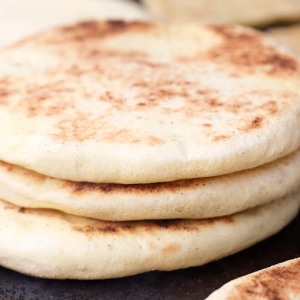
Moroccan Batbout (Marmiton)
Flatbread: Characteristics and Categories
What we call flatbread today is the original, primitive form of bread, historically. The discovery and widespread use of sourdough around 5,000 years ago led to the emergence of much thicker breads. However, flatbreads have maintained their popularity. As we are about to see, some of them even incorporate a small amount of leavening in their preparation.
If we had to describe this bread with only one word, it would be simplicity. Its thickness varies from a millimeter to a few centimeters, making it easy to break them with your hands (one less knife to clean!). It can be prepared with a wide range of grains (wheat, oats, corn, etc.), spices, seasonings, and cooking methods.
Early patty-like types could be cooked on a hot stone, on a grill, under a pile of ash, or in a clay pot. Today, they are generally prepared on a frying pan or in any type of modern oven.
Flatbreads can be categorized into two main types: single-layer and double-layer. Single-layer types can be prepared with yeast (Naan, Barbari, etc.) or without yeast (Yufka, Paratha, etc.), while double-layer types (Pita, Baladi, etc.) are always leavened.
There are many different kinds of flatbread around the globe. Here are some of the most popular ones worldwide:
1. Unleavened Flatbreads
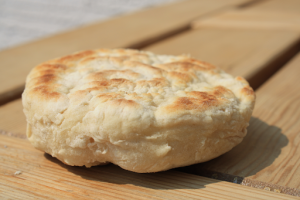
A nice warm Bannock (morselsminus)
- Bannock
Bannock is a traditional pan-fried or baked bread typical of Canada’s aboriginal communities. Like the Indian pudding, it is the result of cultural exchange between First Nations and European settlers, made from wheat or corn flour, water, fat, lard, and sometimes milk. Ease of preparation and nutritional qualities have made it a food of choice in times of scarcity. Most of North America’s indigenous peoples have developed their own versions of it.
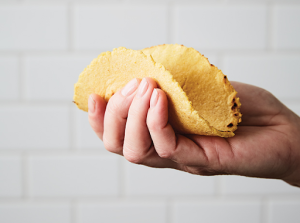
Tacos-shaped corn tortilla (Maison et demeure)
- Corn tortilla
Tortilla is one of the signature dishes of Mexican cuisine, made from corn flour for over 9,000 years. Corn is native to this part of the world, and was the main cereal grown there before the Spaniards introduced other grains. Although nowadays there are industrialized wheat-based versions, tortilla cornbread remains the staple of the Mexican and Central American diet.
On average, Mexicans eat almost 90 kilograms of this bread in one year! With its soft, elastic texture, it enhances the flavourful, spicy ingredients of Mexican cuisine. It serves as a base for typical dishes such as tacos, quesadillas, enchiladas, burritos, and fajitas.
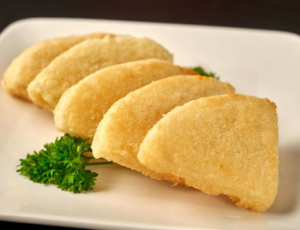
Bammys to enjoy (Grace)
- Bammy
Although it can be mistaken for a cake or a pancake, bammy is a flatbread originating in Jamaica. It is made from cassava flour, a root crop widely cultivated in tropical regions. It can be fried or baked on a hot griddle. Nourishing, made from gluten-free flour, it can be enjoyed either on its own or as an accompaniment to various Jamaican meals.
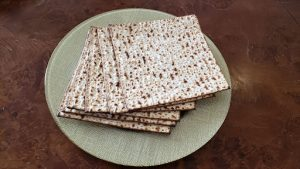
Slices of Matzah
- Matzah
Matzah or matzo bread holds significance in the Jewish culture as a customary food item. The dough is kneaded quickly and rolled into thin sheets, then baked at high temperature for a short time. This gives the bread a delicate appearance and a crunchy texture. In Jewish tradition, it is associated with the exodus of the Hebrews from Egypt, an episode in which they had to flee without having enough time for the bread to rise. It is traditionally eaten during the week of Passover, both plain and in the form of Desserts for Passover.
2. Leavened Flatbreads

Hot barbari with cucumbers and olives (King Arthur)
- Barbari
Barbari is a bread of Iranian origin, also known as “Persian flatbread” in North America. Like the pretzel, it is brushed with a baking soda solution before baking, which gives it its characteristic crisp exterior texture. It is often topped with sesame or nigella seeds (black seeds with a toasted onion flavour), and usually accompanied by Lighvan, a sour, hole-filled cheese traditionally made from sheep’s milk.
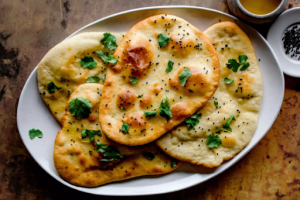
Naan oven-baked (The Spruce Eats)
- Naan
Naan also originated in Iran but has become emblematic of Indian cuisine. In fact, it was introduced to India in the 16th century by Persian invaders.
It is made from a leavened dough of wheat flour, yeast, yogurt and milk, and sometimes other ingredients. It is brushed with oil or ghee and baked against the walls of the tandoor, a traditional clay oven. The classic version is plain, but you can also find Naan with garlic, cheese, herbs, or even meat or vegetables. Thanks to its soft texture, it goes wonderfully well with popular Indian dishes such as Curry or Tikka masala.
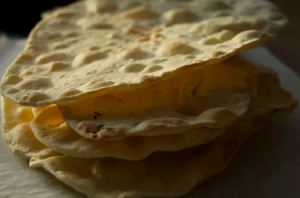
Fresh Carasau (Food52)
- Pane Carasau
Carasau bread originates from Sardinia, an island in Italy. It is made from wheat flour, water, yeast, and salt. The dough is rolled out thinly into a disk shape and baked over several steps in a wood-fired oven. Traditionally, carasau bread was made to last a long time, as it was used by shepherds on their long journeys in the mountains. Its crisp texture meant that it could be kept for several months without deteriorating. Today, it is eaten fresh, as an accompaniment to a variety of dishes, or dipped in olive oil, coffee, or wine.
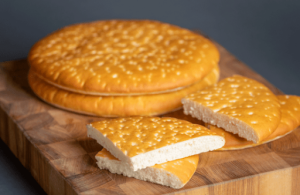
Hönökaka cut in slices (Bakels)
- Hönökaka
Hönökaka bread is a traditional Swedish bread from the island of Hönö, in Sweden’s Gothenburg archipelago. It is a regional specialty, much appreciated for its soft texture and delicate flavour.
Traditionally, this bread was baked in community ovens on the island of Hönö. Inhabitants would gather to knead the dough and bake it together, creating a moment of conviviality and sharing. The bread is often served on Swedish holidays and special occasions, usually garnished with butter, cheese, smoked fish, or cold meats.
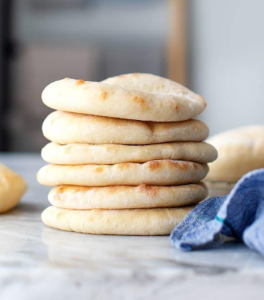
Home-made pitas (Love & Lemons)
- Pita
Originating in the Eastern Mediterranean, pita is a two-layer bread that goes well with all kinds of foods. It is often used to contain or wrap foods, whether crudités, meats, falafels, or Sabich (an Iraqi Jewish dish). In the Middle East, pita is often served with dips such as baba ganoush, hummus, or tabbouleh.
Monoculture and Environmental Risks
While cereals have historically been grown on small family or community plots alongside other complementary crops, today’s growing urbanization and demographic explosion have imposed large-scale cultivation of staple cereals on feeding the world’s population. As a result, fields of wheat, corn, and other cereals now stretch as far as the eye can see.
This type of cultivation, in which a single species is grown over a vast area, is known as monoculture. Although this technique has definite advantages in terms of productivity and efficiency, it has a number of constraints as well.
Firstly, intensive monoculture farming can have a negative impact on soil health. The specific nutrients required by a single crop are often depleted, leading to long-term soil degradation. This situation leads farmers to increase the use of chemical fertilizers in order to maintain high yields.
What’s more, when an entire region depends on a single crop, epidemics, and pests can spread rapidly, causing massive crop losses. These risks prompt farmers to intensify their use of pesticides. However, these chemicals can have adverse effects on waterways, soils and beneficial pollinating animals and insects such as bees. What’s more, pests can sometimes develop resistance to these pesticides. So, in addition to being costly for farmers, dependence on chemical inputs poses risks to human health and the environment.
Another problem caused by monoculture is that overexploited, nutrient-depleted soils present an imbalance in their structure, causing a reduction in water retention capacity. Therefore farmers are forced to increase water use, leading to overexploitation of local sources such as rivers, lakes, and reservoirs. This can exacerbate water scarcity problems in regions where water resources are already limited.
In response to the risks and damage caused by monoculture, alternative approaches are emerging as viable alternatives. These approaches seek to strike a balance between agricultural productivity and the preservation of soil, biodiversity, and the overall health of agricultural ecosystems. Among these approaches to sustainable and resilient agriculture is regenerative agriculture.
The Promises of Regenerative Agriculture
Regenerative agriculture is an approach that aims to restore and enhance agricultural ecosystems. Unlike conventional methods that focus primarily on short-term high yields, regenerative agriculture takes a holistic, long-term approach to maintaining and improving soil health, biodiversity, water quality, and ecosystem resilience, while reducing greenhouse gas emissions. This is achieved through practices such as crop rotation, grassland and animal management, and water harvesting.
The three fundamental aims of regenerative agriculture are:
-
Soil health: By promoting practices such as permanent vegetation cover, crop rotation, organic nutrient management, and no-till, regenerative agriculture increases soil organic matter, improving its structure, fertility, and water-holding capacity. It also favours the use of green fertilizers such as compost and manure.
-
Biodiversity:
Regenerative agriculture promotes diversity of crops and plant and animal species on farms. Different species are grown in association and on a rotational basis. Trees and hedges are planted to enhance biodiversity, and animals are used to enrich soil nutrients. This promotes ecosystem resilience, reduces the risk of disease and pests, and improves pollination and soil fertility.
-
Water conservation: The focus is on efficient irrigation practices, rainwater management, the creation of buffer zones, and the preservation of water resources. The aim is to minimize water losses and maintain a healthy water balance for crops, ecosystems, and local communities.
In Canada, the Montreal-based organization Regeneration Canada promotes regenerative farming methods by creating spaces for learning and exchange, with the aim of inspiring farmers, landowners, scientists, agronomists, businesses, community organizations, governments, and citizens to take action to regenerate soils.
Regenerative agriculture offers us the hope that in the future we’ll all be able to consume flatbreads produced in a sustainable, environmentally-friendly way. With so many ways to enjoy it and so many variations, there’s something for everyone! If this type of bread has piqued your curiosity, you can use Dessert Advisor’s search tool to find bakeries offering bread near you.




